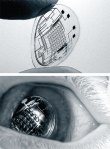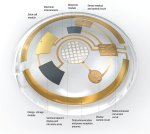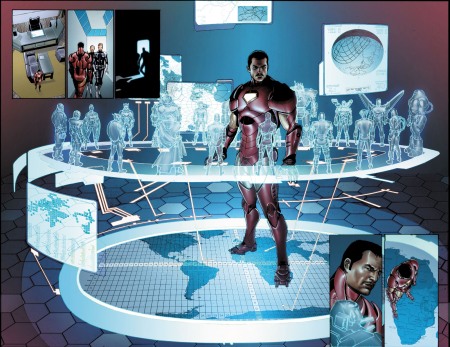Bionic Eyesight (srsly)

With electronic contact lenses, bionic eyesight could become reality
By Andrew Nusca
A new generation of contact lenses built with tiny circuits and LEDs could make bionic eyesight a reality. Researchers at the University of Washington in Seattle have created contact lenses with built-in electronics and an LED, powered wirelessly by RF.
“These lenses don’t give us the vision of an eagle or the benefit of running subtitles on our surroundings yet,” University of Washington professor Babak Parviz writes in IEEE Spectrum. “What we’ve done so far barely hints at what will soon be possible with this technology.” While conventional contact lenses are polymers formed in various shapes to correct faulty vision, electronic contact lenses are far more “engineered.”
“What we’ve done so far barely hints at what will soon be possible with this technology.” While conventional contact lenses are polymers formed in various shapes to correct faulty vision, electronic contact lenses are far more “engineered.”
Parviz writes:
To turn such a lens into a functional system, we integrate control circuits, communication circuits, and miniature antennas into the lens using custom-built optoelectronic components. Those components will eventually include hundreds of LEDs, which will form images in front of the eye, such as words, charts, and photographs.
Much of the hardware is semitransparent so that wearers can navigate their surroundings without crashing into them or becoming disoriented. In all likelihood, a separate, portable device will relay displayable information to the lens’s control circuit, which will operate the optoelectronics in the lens.
The potential for the development is far-reaching, from healthcare (noninvasive health indicators, such as reporting blood sugar levels for diabetic users) to computer gaming, translation to navigation.
Even the Internet is possible, Parviz writes:
“With basic image processing and Internet access, a contact-lens display could unlock whole new worlds of visual information, unfettered by the constraints of a physical display.”
But the initial road is for health purposes, such as the aformentioned biosensors:
Contact lenses are worn daily by more than a hundred million people, and they are one of the only disposable, mass-market products that remain in contact, through fluids, with the interior of the body for an extended period of time. When you get a blood test, your doctor is probably measuring many of the same biomarkers that are found in the live cells on the surface of your eye—and in concentrations that correlate closely with the levels in your bloodstream. An appropriately configured contact lens could monitor cholesterol, sodium, and potassium levels, to name a few potential targets. Coupled with a wireless data transmitter, the lens could relay information to medics or nurses instantly, without needles or laboratory chemistry, and with a much lower chance of mix-ups.
There are still hurdles. First, mass production has proved difficult, since the processes for building individual systems for the electronic contact lens are incompatible — they can’t be manufactured directly on the lens. Second, all the key components of the lens need to be miniaturized and integrated onto just 1.5 square centimeters of a flexible, transparent polymer. Finally, the entire device needs to be safe for the eye — difficult, since most red LEDs are made of a toxic material.
Second, all the key components of the lens need to be miniaturized and integrated onto just 1.5 square centimeters of a flexible, transparent polymer. Finally, the entire device needs to be safe for the eye — difficult, since most red LEDs are made of a toxic material.
The team has produced lenses that can accommodate an 8-by-8 array of LED, but Parviz writes that the team is already looking into using passive pixels, which would significantly reduce power draw.

Leave a comment